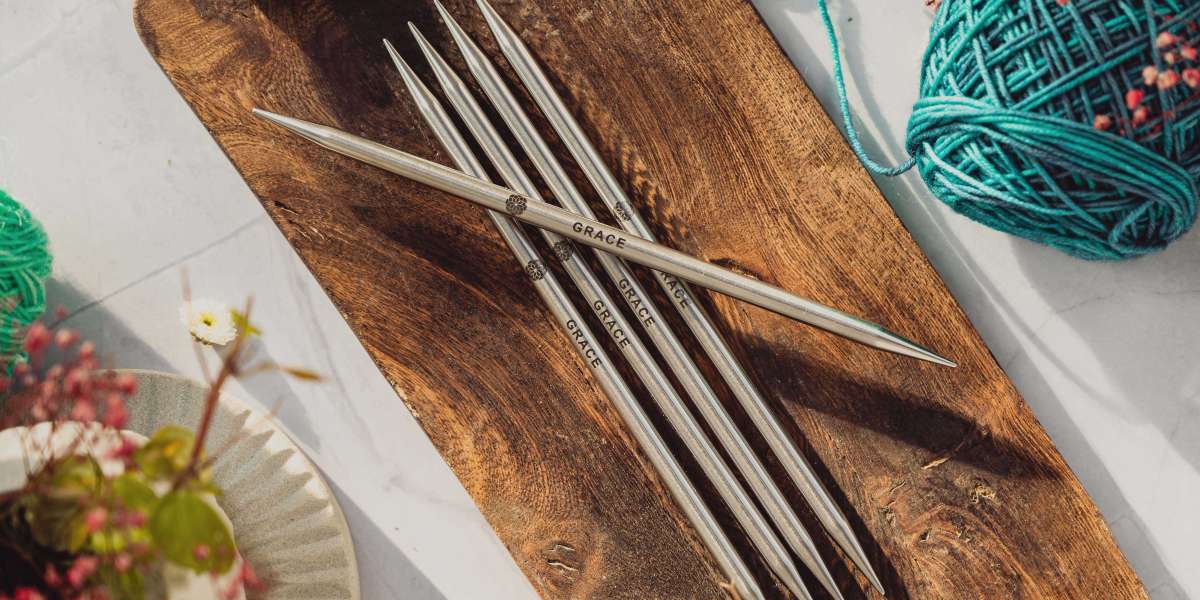Knitting with double-pointed needles is the best way to work on small circumference projects. Knitters love their double points, and there are many reasons to do so. The oldest method to knit round projects, the set of five needles with pointy tips on either end is ideal for socks, fingers of gloves, baby hats, and more. It is fun to manage the multiple needles and see your project grow. If you are a beginner or if you previously have had a bad experience with DPNs, we have some handy tips.
- Avoid Laddering by tightening up the Second Stitch on every Needle
Laddering is a common problem when knitting with double-pointed needles. Ladders mean gaps between two stitches that happen at the point where you switch the needles. Most knitters would suggest maintaining high tension but the trick is not pulling the first stitch tight, instead, tighten up the second stitch. This way the yarn you pulled is tight and stays in position.
- Slipping a stitch to make an Invisible Join
Many knitters believe that knitting the first round on double-pointed needles is usually the most difficult one. As you are just getting used to the needles, you tend to stretch the stitches on that round a bit more than after working on the next rounds.
To make this easier, always cast on one more stitch or start with a simple loop instead of a slipknot. Slip this extra stitch of the first needle (the DPN you cast on stitches) back to the last needle (the last DPN). Now slip the last stitch on the previous DPN over the slipped first stitch. This technique is similar to bind-off. Drop the stitch off the needle and then slip the remaining stitch back into the first needle. Make sure to tug on the yarn tails to tighten the gap even further. This creates an invisible yet firm join.
- Keep the working needle on top
Knitting with double-pointed needles requires you to understand “needle management”. Your working needle must not be trapped under other needles or else you would be knitting in an uncomfortable position. So, whenever you are about to move to another needle, always do these:
- Slide the stitches you have worked to the middle of the DPN so they can’t accidentally slip off.
- Then move the left tip of that needle under the new working needle.
- Meanwhile, also bring the other end of the new working needle to the top. And, in case, if the working yarn gets trapped in between two needles, untangle it.
Your working needle is free to work like you want to. Once you repeat these steps for a few rounds, you will get into the habit of ensuring the working double-pointed needle is free from the tangles.
- Avoid Complicated Stitches For The Last Two Stitches On A Needle
The last two stitches on the double-pointed needles need to be tight and uncomplicated. It is better to stick to 1 knit or purl stitch at the edge. The K2togs, SSKs, and stitches involve 2 or more stitches for the decreasing of the toe of a sock pattern or the gusset must be avoided. These stitches steal a bit of yarn, causing loose stitches and yarn floats that will cause ladders.
- Add The Stitch Marker The Right Way
Stitch markers are knitting essentials, assisting the knitter in various ways. Placing the stitch marker in the right way when working with double points is very important. It is not possible to place the stitch marker at the end of your needle as it would simply slip off the pointy tip. You have to place the stitch marker between the first and second stitches. A locking stitch marker works the best. Even if the marker gets tangled in the fabric, you can easily remove it. If you do not want to use stitch markers at all, the yarn tail of the cast-on tail will always help you identify your first needle (the one you cast stitches on).
If you are knitting Fair Isle or any other colourwork method, there’s probably more than one yarn tail. In this case, slip the last stitch of the last needle onto the first needle, and then place your stitch marker between those two stitches.
And then there’s practice
Not a tip at all, but a thought of every knitter- getting practice. Knitting with DPNS takes quite some practice. In your first attempt, your brain and muscles never had the chance to actually learn it properly, so the second time is the charm.
Another point that knitters have on their minds all the time is suitable knitting needles. Always make sure to have double-pointed needles that you enjoy working with. The Mindful collection offers a range of stainless steel knitting needles with pointy tips and an inspirational word imprinted on the needle tip to assist knitters to focus on the mindful craft.
Source: https://mindfulknitpro.nethouse.ru/posts/knitting-with-double-pointed-knitting-needles
 " class="wow_main_float_head_img">
" class="wow_main_float_head_img">







